By John Lorinc and Kimberley Noble
The information shouldn’t come as a surprise, but the numbers are nonetheless startling.
According to data obtained by Spacing under access to information requests, development in three downtown wards — the eastern portion of Trinity-Spadina, and the two halves of Toronto Centre — generated 47% of all the revenues that flowed into the city’s parkland acquisition reserves between 2011 and 2014.
The dollar amounts, moreover, are huge: across the city during this three-year building boom, developers anted up $298.5 million, to be spent on new parks or the development of existing ones. Those three wards (20, 27 and 28) between them produced $142.6 million of that total, thanks in large measure to the forests of high-rise condos that have sprung up south of Bloor in recent years.
What’s more, the South District — taking in most of the former City of Toronto and East York – generated 69% of the total parkland reserve revenue in the period we canvassed. Except for growth nodes like Yonge/Eglinton, Lakeshore Road in south Etobicoke and the North York City Centre/Sheppard avenue corridors, the rest of Toronto contributes relatively little to this fund.
To put those skews in context, the developer of a single large project – 1 Bloor East – poured $10 million into the parkland reserve. That figure is just less than the entire amount collected for the three-year period for all of Scarborough.
PARK ALLOCATION FUNDS COLLECTED, 2011-14
What’s far less clear is what ultimately happens to all the money that pours into the city’s rapidly growing parkland reserve funds. The policy framework for spending those dollars is complex and, despite drastic changes in the real estate market, hasn’t been updated in well over a decade.
City staff occasionally release reports with updates on the state of the parks acquisitions programs in response to requests from council, and also there’s information on the sums held in various parkland acquisition reserve funds buried deep inside the capital budget. But there’s no analysis of where the money comes from, how it is spent and whether these investments in Toronto’s public open spaces conform to council’s long-standing parkland provision policies, which are laid out in the Official Plan.
Spacing has examined years of detailed city data on these levies and the associated parkland creation. One conclusion is glaringly clear: that despite the huge sums generated by downtown development, and the associated population growth, the municipality has created a scant amount of new park space in these intensifying downtown areas, which, according to the city’s 12-year-old “parkland provision” map, are deemed to be deficient in public open space.
Between 1998 and 2014, the City of Toronto created 242 hectares of new park space – an area about two-thirds the size of the Toronto Islands. The total includes everything from playing fields and community centre land parcels to bits of ravine slope, trail improvements and seating areas on downtown street corners.
But according to the city’s breakdown of all new parkland created since amalgamation, just 15% (in terms of area) is situated in South District. Waterfront Toronto’s new parks — Corktown Common, Sugar Beach, Underpass Park and Sherbourne Common, as well as a large sports field in the Portlands — account for a significant portion of that figure.
More problematically, the pace of new park creation across Toronto has slowed sharply since the 2009 recession, even though the building boom has ramped up. In the first decade after amalgamation, the city added, on average, 19 ha of parks per year. Since 2009, that figure has dropped by half, to 9.2 ha per year.
The story gets even more discouraging in the intensifying core area that corresponds to the old City of Toronto and parts of York and East York. Across the South District, as this region is known inside the civil service, the city established just over 6 ha of new park space during the past five years; much of that total involved transfers of land from other public agencies. Since 2009, developers building in South District dedicated just under 2 ha. Meanwhile, the city used its parkland cash reserves to acquire only 0.7 ha across all of South District between 2009 and 2014. For context, Nathan Phillips Square is 1.2 ha.
Table 1: New parkland since 1998, broken down by land dedications by developers; acquisitions of land by the city; and transfers of real estate from other agencies. South district, which includes the former City of Toronto, as well as parts of East York and York, accounts for just 15% of all new parkland – 36.9 hectares — added since amalgamation.
| Total | 1998-2008 | 2009-2014 | South District (1998-2004) | |
| Dedications | 63.1 ha | 57 | 6.1 | 12.8 |
| Acquisitions | 62 | 53.3 | 8.7 | 12.5 |
| Transfers | 117 | 81 | 31.2 | 11.6 |
| Total | 242 | 191.3 | 46 | 36.9 |
(Source: City of Toronto)
Council has never seen this analysis because no one’s ever asked for it before.
The last significant staff report presented to the decision-makers was tabled in October, 2013. Between 2010 and 2013, according to that analysis, officials acquired a dozen parkland sites (7.42 ha) across the entire city, and spent just $25.9 million on those purchases. Yet only one – a parkette at St. Joseph and Bay, acquired for $600,000 in combination with a land dedication by a large developer – was in South District. “The last large purchase of parkland in the South District was 90 Lisgar [in the West Queen West area],” the report added. “That purchase of 2,960 m2 of park space was made in 2008.” The price-tag: $6,149,600.
The picture is noticeably different in low-density suburban areas. The most costly site acquired between 2010 and 2013 was a 2.5 ha school yard off Sheppard Ave. W., between Bathurst and Wilson Heights. Its purchase price: $7.5 million.
(Council last year approved four more park acquisitions. One is a lawn bowling field and church lot near Mount Pleasant and Eglinton. Another is the latest addition to an assembly of parkettes just east of the North York City Centre corridor. The two others include the 0.6 ha park negotiated by Kristyn Wong-Tam at 11 Wellesley, and a 2 ha plot behind a North York school near Wilson and Highway 400. None of the prices were disclosed.)
Funds spent for parks acquisition since 2009
So what’s become of the tens of millions sitting in the parkland reserve funds and earmarked for the expansion or enhancement of the city’s green spaces?
According to council’s 2014-2022 capital budget for parks, forestry and recreation (PFR), the city doesn’t intend to reverse the dramatic decline in parkland acquisition. During that period, the city will spend $10.8 million on land purchases, compared to $108 million on park development projects. That’s a ten-to-one ratio, even though half the parks levies collected by the city is meant for park acquisition.
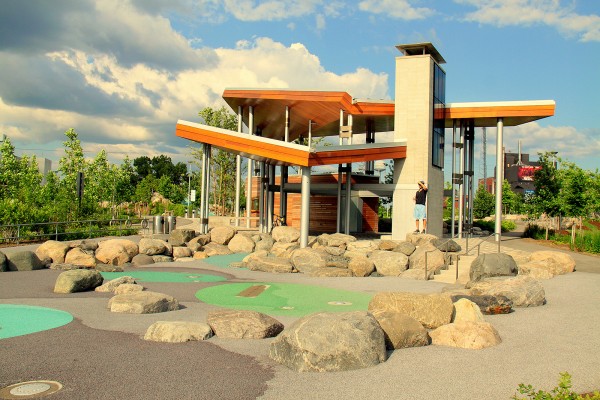
The reasons for the discrepancy are both subtle and obvious.
Internally, PFR’s parkland acquisition team consists of just three people, including one administrative assistant. This tiny unit is responsible for identifying, appraising, and purchasing parkland across the entire city. The parks planning team is somewhat larger, but there are still only a handful of landscape architects assigned to design parks for an entire city. The group must also scramble to deal with unexpected events, such as flood and ice storm damage. With so few civil servants assigned to implement the policy, it’s little wonder the deal flow has slowed to a trickle. “If somebody said, ‘here’s $100 million, let’s go,’ — there isn’t the staff to execute those kind of projects,” observes one city official.
As well, says another source with close knowledge of the city’s planning processes, PFR officials consistently raised objections in recent years to the creation of new parkland absent clearly identified sources of operating funds to cover maintenance and personnel required to manage those new assets. “They didn’t want new parkland because they couldn’t afford to maintain what they had already. Unless a new park had money for maintenance, they weren’t interested.”
Yet the over-heated state of the property market, especially in desirable areas, accounts for the most significant explanation for why the city isn’t buying land in the parts of the city that need it most. PFR officials have to sign off on every development application, but a dearth of nearby open space will never be a deal breaker. Moreover, each application, PFR officials told me, is judged individually; city staff don’t assess the aggregate impact of high density development in a given area — e.g., King West — on the supply of open spaces in the vicinity of those projects. (As anyone who’s recently visited the increasingly crowded lawns at Trinity-Bellwoods Park on a nice day can attest, the cumulative affect of high-density development in the area is difficult to ignore.)
While the balance in the parkland acquisition reserve fund has grown significantly in recent years, PFR officials also say the city can’t compete in a highly speculative downtown real estate market where an acre of land sells for anywhere from $30 to $60 million.
Moreover, the City of Toronto Act forbids the municipality from offering bonuses to builders or paying more than the appraised value of the land, even though market prices are considerably higher. As a senior PFR official told me, “We really struggle to buy sites that are appropriate and have a willing seller.”
Part 1: All built up but no place to grow
Part 2: Where the money flows
Part 3: The perils of cash-in-lieu
Part 3 sidebar: Section 42 explained
Part 4: The tale of two parks
Part 5: The system worked (slowly) for a west end park
Part 6: Are privately-owned public spaces the answer to parks deficit?
top photo by Neal Jennings; middle photo by Wylie Poon; all maps by Sean Marshall

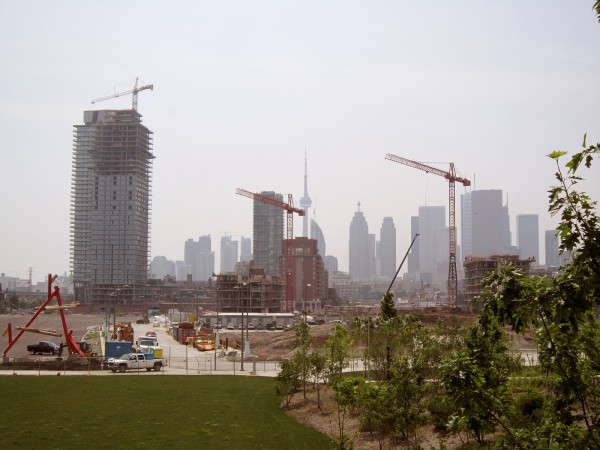

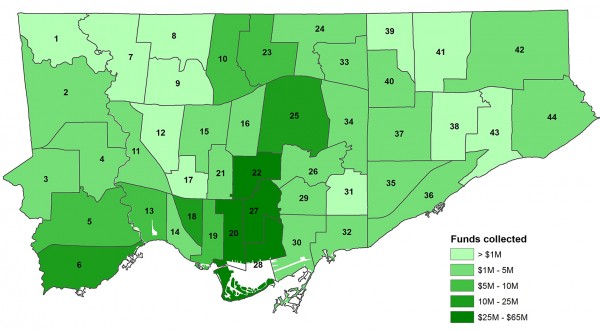
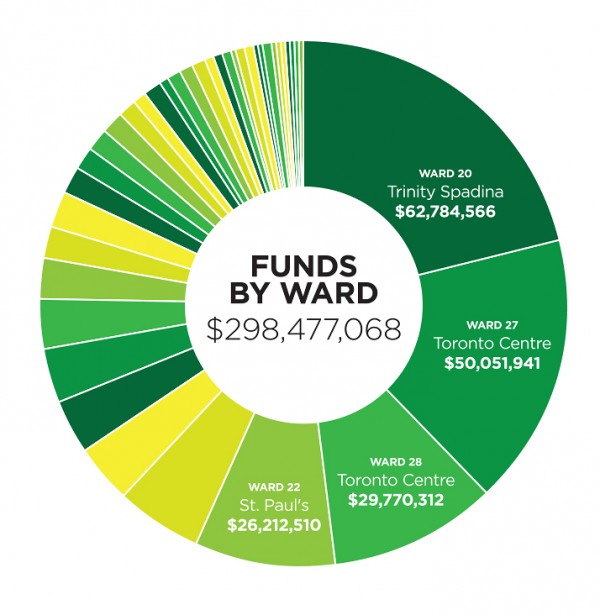
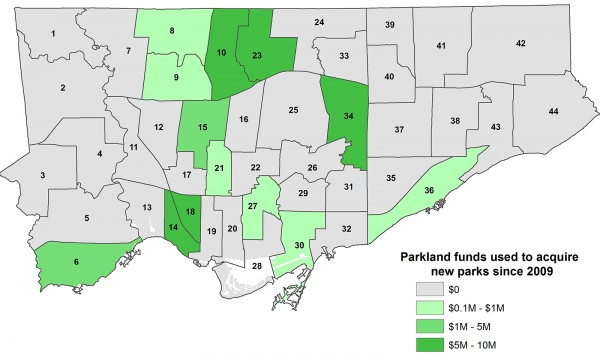



16 comments
Are we really complaining that the city isn’t spending it’s money fast enough? If the city wants to make parks – it usually makes more sense for it to convert it’s existing land holdings into parks than buy out an individual landowner.
Secondly, the city usually makes smart decisions about where and how to make parks. If that takes time – so be it. The recent extension of Stanley Park southwards towards Fort York is just one of these fairly spot-on decisions.
Thirdly – I think you’re conveniently forgetting about some mega park projects that have to be paid for in the next decade or so. Think about the lower don lands park plan – it’s a huge addition of park space to the city that could easily eat up half that parks budget. Moving a river and making flood barriers isn’t cheap work.
We’ve probably added more park space downtown than any other city has in the last decade. Think of Regent Park, Canoe Landing Park, June Callwood Park. And we’re investing into our existing parks – the Grange will be completely renewed in the next few years.
Lastly the notion that Trinity Bellwoods is somehow overcrowded is absurd. Visit any square in London to see what real overcrowding looks like.
Josh’s comment above is what a bureaucrat would argue, not a resident. To maybe answer his questions:
1. Yes, the City isn’t buying park land fast enough. It should be a part of the process of the building application. They know the building is coming for years in advance.
2. The City doesn’t always make the right choices of parks. They haven’t spent any money in the last 5 years to even back up that notion. Thus, the reason for this report.
3. Park allocation funds do not go to mega parks like the lower don lands. That’s a waterfront Toronto. All the money that has been collected from these buildings is supposed to go towards parks in the vicinity of the building, not pay for mega parks. Also, the parks you named (Canoe Landing, June Callwood) were from money before 2010 and what this piece is investigating.
4. T-B Park is overcrowded. We don’t have to trvel around the world to see this. We don’t have to get to super over-crowded spaces to force the city to make more.
In whole, Josh’s comment is totally an apology for the parks department laziness and fear of the Fords.
It seems there are two parts to the problem of spending the Parks Reserve Fund: the acquisition of new lands in park-deficient areas, and organizing the City’s processes and staff to improve lands it owns already that are zoned as open spaces currently. Cases in point abound around Fort York which sits in the centre of several fast-growing neighbourhoods. There’s the area under the Gardiner along Fort York Boulevard, where for the want of a watering system and modest landscaping wild grasses might grow down the ramparts to the road. When built, the park north of the new library on the east side of Bathurst is meant to flow under Bathurst and connect with paths and trails along the north side of the fort over to the south end of the new pedestrian-cycling bridge over the rail corridors. Within the Fort York National Historic Site itself funding has not been identified for all the landscape improvements–the relocation of parking lots and roads–projected to take place. And north of the fort the ‘South Stanley Park extension” of nearly 7.5 acres rezoned from industrial to open space by Council last August awaits inclusion in the City’s 10-year capital works plan.
I disagree with Joanne:
If you aren’t dealing with a reference of “park’s in other large cities” how do you know if T-B is over crowded. Land is expensive. Buying more parkland downtown, and taking it out of the marketplace will only make all other land-related costs (e.g. property taxes) all the more expensive. And increase the upkeep costs for all parks (though I guess we could just try to cover more land with the same budget and settle for less upkeep.)
I’d much rather have a few quality parks than a lot of poor-to-mediocre ones taking up space, not being maintained, and depriving us of alternate land uses.
I’m not a bureaucrat, I’m just a reasonable resident of this city.
Here’s why your points are off:
1. Why are we looking at ‘fast enough’ – why should speed play any factor in the way we plan our cities. We should not be building parks as if each building that goes up deserves it’s own park. If we built this way we would end up with many tiny and functionless parks. It’s totally okay to let money stay in the bank for a while.
2. There’s many examples that prove this wrong – including the new South Stanley Park & Ordinance Triangle Park.
3. It’s a very bad argument to completely disregard all of the parks Waterfront Toronto has created in the last few years. Sure the money is coming from elsewhere, but the area’s in need are being serviced by brand new parks. Fantastic new parks.
4. Trinity Bellwoods might be slightly crowded on a Saturday afternoon in June – the rest of the time it’s completely underutilized. The same twisty logic is what people used to try and justify the Spadina expressway. Besides, there are already parks near Trinity Bellwoods like Fred Hamilton Park and George Ben Park which are completely underutilized. Trinity Bellwoods is a special place that will always attract crowds no matter how many other parks you build near by.
So far, this is a great series as it highlights an important issue. For years, I have felt that the city should be building more parks in the core, but it’s good to see fact-based evidence that shows that.
I would also like to see you explore the types of park spaces being built. I feel like the city is only interested in building open spaces and aesthetic parks. It seems like there’s little interest in building sports fields. We give good lip service to encouraging active lifestyles, but there seems to be no space for organized sports in the city. I have unsuccessfully tried to get permits for fields several times. It seems that if you want to play team sports, you have to travel to fields in the inner suburbs.
Josh:
re: Fast enough — I suspect you read this article, but the Parks Dept doesn’t plan to spend much, if any, money on new parks up until 2022. Expecting a park in areas that residents have paid for with the purchase of the condos/homes shouldn’t expect new green space to appear a generation after they’ve moved in. Money from the allocation fund have helped a few parks be rehabilitated, but that’s only part of the purpose of the fund.
re: waterfront parks — this investigation, as its clearly stated, is about the parks allocation fund and money collected; waterfront toronto has paid for much of those parks you mention. I think those parks are great but they’re the outliers in this report, not the standard.
Rirchard: “If you aren’t dealing with a reference of “park’s in other large cities” how do you know if T-B is over crowded.”
Oh pleeeeeeease…. I can go to TB Park and see if its crowded or not. I don’t have to go to London to understand crowded parks. besides, this isn’t about overcrowded parks — this is about how money that residents expect to be spent on parks — and have paid for not thru property taxes but through the purchase of their condos — is not being built, as promised. Capital F fail for the parks department.
I think there’s a false assumption in here that new giant parks are actually possible in the core. We’d all like new baseball fields, and soccer fields – but you can’t just stick these in the middle of the city – no matter how much money the city has. You’d have to destroy half the city to include the amount of local parks people are actually requesting. The reality is – people will need to go further to get to sports fields as the city intensifies. The city can’t magically produce new land.
The city is not having a parks crisis. This sounds like a headline straight out of Sun News. Toronto is literally showering itself with new parks all over the city, even when you don’t include Waterfront Toronto.
Let’s name a few:
1. Ontario Place
2. Downsview Park
3. Rouge Park
4. Corktown Common
5. June Callwood Park
6. Canoe Landing
7. The Ordinance Triangle Park
8. The Common at Fort York
9. The Ashbridges Bay Skate Park
10. The ENTIRE DON VALLEY
11. Regent Park
12. The Southern St. Lawrence Market Park
13. The Park at 11 Wellesely St
Plus Grange Park, Berczy Park, & College Park are all being completely renewed.
Then you consider the entire Waterfront is being renewed with another boatload of parks. The amount of parkland development is this city is actually staggering. To make it out as a dearth is misleading and sensationalist.
The above comment by Sam makes me believe some people (like him) are reading one or two paragraphs and then jumping in to comment. Because his list clearly illustrates that he doesn’t get what this report is about: large sums of money, dedicated to creating new green space as per the deal between developers and the city (and thus residents), is being tucked away with no plan to spend. More so, in the areas that need parks, such as downtown, aren’t receiving the promise they were given when they bought their condos downtown. 75% of his list has nothing to do with the parks allocation fund and the areas mentioned are not in dire need of green space.
I get frustrated with these types of comments since this report clearly shows that the city has $300 million in funds to buy parks or upgrade existing ones, and has no plan to spend that money. Imagine if that happened with property taxes? Taxpayer groups would be up in arms! But because its condo owners many will dismiss it as trivial.
Very happy to see this report and shedding light on the parks department’s shortcomings and city halls short sightedness.
Also like to add to Sam’s comments “Plus Grange Park, Berczy Park, & College Park are all being completely renewed.”
• Grange isn’t being renewed as much as it was supposed to. Parks won’t cough up money to do it right.
• Berczy Park got a minor facelift.
• College Park: the city has again balked at the price and has walked away from the original plans leaving it in limbo.
Before the railways arrived in the 1850s, the downtown crown reserves at the Garrison, east of Berkeley and along the shoreline exceed the size of Central Parl in New York. Halifax, Montreal, Vancouver, Victoria and others have generous downtown parks. While other cities were acquiring parks for their growing populations, Toronto was selling off its own. True there are parks galore, in the GTA but not downtown, within easy walking distance. Stanley Park in Vancouver is 1000 acres or so. Point Pleasant Park in Halifax is over 100 acres. Now those are PARKS.
Great research on the topic but just wanted to share my two cents on the issue.
1. I don’t think people are moving downtown because they are expecting the city to build them a park. There are a ton of amenities close by that attracts people, including expensive amenities that they pay for in their new condos.
2. I understand that parks collects money to be spent on parkland acquisition, but with the cost and scarcity of land downtown it may not be the wisest choice to pump millions of dollars into a small park. Money could be better used fixing existing parks.
3. In general I don’t think there is an undersupply of park space downtown. I lived in city place for a few months and I would hardly say that people are crawling over each other to use that park. Even though thousands of people have moved to the area they park is rarely too busy. Liberty village also comes to mind. It seems like there is not enough park space, but the little park it has is hardly overcrowded, and you have great open spaces nearby including bellwoods, the waterfront, and the little park by lamport stadium that barely anybody uses.
4. The Parkland Provision Map in the Official Plan is deeply flawed and I would be very careful when making assumption based on some sort of formula that the government has produced especially if distributes information along ward boundaries. If you look closely, Parkdale is deficient in parkland yet it is right next door to High Park and the waterfront. One could make an assumption based on this map that the city should spend money on buying park land in parkdale because it is deficient but the parks their are not too busy and there are some great parks close by that are easy to get to. because this map deems an area deficient should not lead to the conclusion that very expensive land should be purchased to increase the net amount of parkland, especially if existing parks are not maintained or are not used well.
I think the parks department should focus on improving existing parks and land holdings and rethink how they spend their money.
Let’s imagine you just got a job in finance – you want to dress the part but your wardrobe is full of casual clothes. You do in fact make good money, enough to save a good chunk every paycheck, and get you that spiced chai latte every morning. You even have enough now for some new clothes pronto. First day is tomorrow.
What do you do? Brad tells you to go to H&M – design is OK, quality is OK. Get some basics that’ll last you a few months. You’ll only need to go back and get replacements. Or send them to get repaired at a minor cost. So you do. You get that $50 blazer that doesn’t quite fit right and two months later it’s got a hole. You spend $30 bucks in repair because its the only one you have. You figure, it’s only $50, let’s get another. And some shirts, and pants, etc. Now you have a wardrobe full of crappy clothes, none of them fitting or lasting, all needing repairs. It’s a lot of work. But it does the job, you can look the part.
Sarah says -stop! Dude don’t you save plenty of cash? And why’s your christmas money just sitting around? What are you waiting for? You can buy the crappy stuff and look your BEST now! you can get yourself a wacky haute couture suit and that omega watch you’ve been eyeing. That’ll last you a life time and fit you perfectly. You’ll look spiffy without all the fuss of repairs every three months. Sarah doesn’t realize it takes time to look for the right tailor that ‘gets’ your aesthetic. And you have to spend some money on getting accessories like sunglasses, shoes, ties and cufflinks which cost a lot added up. Plus you have to get some bday gifts this month. AND you have to be sure you can even afford any repairs, if necessary.
Sarah keeps nagging at you about letting your money sit around (as if you don’t have plans for it!). It’s annoying, so in the meantime you buy a used omega watch. Actually, it makes you feel like you’ve made some progress in your wardrobe upgrade.
Now imagine that everything you can buy can only be bought on ebay. But this is a strange version of ebay where because you haven’t joined the coffee club yet, you can only bid the lowest possible bid. Not only that, but there aren’t a lot of blazers and shirts that are your size. When you do find that gem – some scoundrel has already outbid you, even though they know you could have worn it best. But wait! Apple has just launched it’s clothing line and offers suits to EVERYONE that only they can repair, only if you buy applecare. And you can only buy applecare if you live downtown but work in a refurbished warehouse. And Cook has to approve your purchase, if he likes you. Repairs are $100/hour.
What’s your next move?
It’s frustrating to have this discussion because there is no data on how parks are used, how often, by whom, when, etc. The only existing current data on park use right now is from the permit system, which limits analysis to sports, big events, wedding photography, etc.
Without quantifiable data on how parks are used, we can only bicker about whether we have enough and whether they’re the right kind.
I have lived in London, Edinburgh, Vancouver and Toronto. Anyone who says that London, or Vancouver (or Edinburgh, or New York for that matter) don’t have large, magnificently maintained parks in their downtown cores is simply mistaken. London, which Josh refers to, has multiple large parks in the downtown core. As for Squares, they serve a different purpose. And quite frankly, Toronto doesn’t even begin to compete with London or any other major European city on that dimension either. The bottom line is that Toronto, for all its residents talk of being a world-class sit, remains a regional super-city, not a global one. And the lack of true downtown parks is one of the glaring reasons why Toronto continues to be more Hogtown (let’s make money, money, money!!!) rather than a civic-minded city with beautiful public spaces where people can congregate and enjoy gardens and sports activities. Unfortunately, there are good reasons why we’re better known for our police carding and ketteling practices than for our parks and recreation. Saying that it is a city within a park doesn’t make it so. Londoner’s and New Yorkers would laugh themselves silly were they to read Josh’s comments.